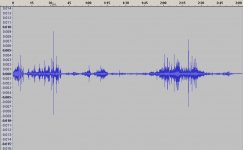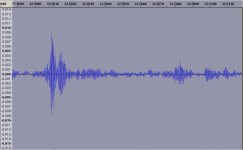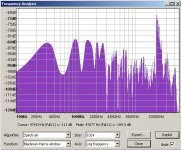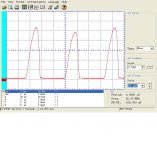Very simple: neutralise the love of money ...
Frank
Indeed. I did it with myself, though the majority of others don't follow…
Here is a picture of the current into the half bridge feeding a small power supply. The transformer is rated 16 Volt CT at .8A and the filter is 10,000 uf and .1 uF, the load is 50 ohms. The image is 16 averages.
So what is so interesting?
So what is so interesting?
Attachments
Here is a picture of the current into the half bridge feeding a small power supply. The transformer is rated 16 Volt CT at .8A and the filter is 10,000 uf and .1 uF, the load is 50 ohms. The image is 16 averages.
So what is so interesting?
Unless a transformer has a bifilar-wound secondary to achieve the center tapped operation, the two halves of the winding will have different resistances, if wound one on top of the other for the same number of turns and hence open-circuit voltages. This leads to a lot of fundamental coming through when you draw current.
Unless a transformer has a bifilar-wound secondary to achieve the center tapped operation, the two halves of the winding will have different resistances, if wound one on top of the other for the same number of turns and hence open-circuit voltages. This leads to a lot of fundamental coming through when you draw current.
And what are the other solutions? BTY this is from a Signal dual primary dual secondary flat-pack!
How many Blowtorch were sell ?but our sales and reviewer rating
Can-you compare your sells with the ones of Marantz, Sony, Philips, Denon, Nad, Pioneer, Rotel, Yamaha etc. ?
Happy new-year George (This is Totally no rational).Although totally unimportant to anyone here, I find no rational in that route.
I agree with you most of the time, and specially on this way
Last edited:
Many talk of the "evilness" of MP3 ... or is it? I took the right channel of that 2L recording of the Britten work, 96kHz, and gave it it the MP3 treatment ... gasp, horror of horrors, it must be totally ruined!! Let's see then: to make it fair I used Lame and forced it to use high quality options, a bit rate of 320kbps. But still, the 52Meg file was clobbered, to output a file just over 7Meg. Heavens, the track must be completely ruined ...!!
Okay, suck the 96k file into Audacity, and the generated MP3, synchronise, invert one and mix, and what does the difference file look like? Like this:

Hmmm, mostly down at least 60dB, not too terrible; but there are a couple of nasty looking spikes, what's in them? Lets zoom in on one:

Well, this looks to be pretty high frequency stuff, I don't think it's going to be audible. But let's look at the spectrum of just that zoomed in bit, what does it show?

Oh dear, mostly very high frequency material - you have to wonder how relevant it's going to be ...
So, this dreadful MP3 business didn't do so horribly after all in processing this "audiophile" recording, so why does it sound so terrible, I wonder ...?
Frank
Okay, suck the 96k file into Audacity, and the generated MP3, synchronise, invert one and mix, and what does the difference file look like? Like this:

Hmmm, mostly down at least 60dB, not too terrible; but there are a couple of nasty looking spikes, what's in them? Lets zoom in on one:

Well, this looks to be pretty high frequency stuff, I don't think it's going to be audible. But let's look at the spectrum of just that zoomed in bit, what does it show?

Oh dear, mostly very high frequency material - you have to wonder how relevant it's going to be ...
So, this dreadful MP3 business didn't do so horribly after all in processing this "audiophile" recording, so why does it sound so terrible, I wonder ...?
Frank
Last edited:
Who pretend MP3 sound "terrible" apart JC and some maniacs audiophiles who love the sound of 40 years old analog tapes ?So, this dreadful MP3 business didn't do so horribly after all in processing this "audiophile" recording, so why does it sound so terrible, I wonder ...?
(Happy new year, fas42, I love your clever way to explore the things).
It do the same job than Mini cassette, hundred time better: provide a light access to music. As far i'm concerned, i just avoid-it like hell from any professional use.
There is no more problem about-it, nowadays, hard disks, USB Keys and flash memory sticks are cheap enough for we do not need-it any more, apart for live web diffusion.
Last edited:
What I would really like to know is what did not work in the experimentation leading toward imperceptible compression algorithms. That would highlight the real aspects we should look to in audio overall. Further applying that knowledge to speakers could be really useful. We know its very difficult to reproduce a "waveform" acoustically. Perhaps the basic concept is flawed and a different approach to creating pressure waves that would better mimic what we hear exists.
And there is the hazard of conflating accuracy and "good sound". Floyd Toole pretty conclusively proved that they are not synonymous, with audiences preferring a rolled off top. Good sound has no bounds or clear target. In fact it could be argued that it can be influenced by aspects that have zero affect on sound. However customers buy "good sound" and like to be told its more accurate.
And there is the hazard of conflating accuracy and "good sound". Floyd Toole pretty conclusively proved that they are not synonymous, with audiences preferring a rolled off top. Good sound has no bounds or clear target. In fact it could be argued that it can be influenced by aspects that have zero affect on sound. However customers buy "good sound" and like to be told its more accurate.
So, this dreadful MP3 business didn't do so horribly after all in processing this "audiophile" recording, so why does it sound so terrible, I wonder ...?
I rather suspect those who say mp3 sounds terrible are listening through a far more terrible DAC
@Demian - did Floyd give details of the electronics he was using when his audiences preferred the HF rolled off? My guess - he had an S-D DAC
Last edited:
Very simple: neutralise the love of money ...
Don't you really mean the addiction to fiat money Frank? I love money and don't consider that any kind of problem
And my suspicion is that the top end that was rolled off in these experiments had a fair bit of nasty low level distortion mixed in. The hardest to eradicate, and the most telling in the battle for "good" sound ...And there is the hazard of conflating accuracy and "good sound". Floyd Toole pretty conclusively proved that they are not synonymous, with audiences preferring a rolled off top. Good sound has no bounds or clear target. In fact it could be argued that it can be influenced by aspects that have zero affect on sound. However customers buy "good sound" and like to be told its more accurate.
There is a clear target: for the sound to convey the impact and experience of the real thing. Unfortunately, high level, in volume terms, sound with an excess of distortion is intolerable, classic PA sound is what you get in this particular corner.
What is needed is sound which can run at PA levels, minus the nastiness that is normally part and parcel of that sort of setup ...
Frank
Even worse is ferrari money ...Don't you really mean the addiction to fiat money Frank? I love money and don't consider that any kind of problem
No, I tend to see it as a money issue, real or otherwise. Every "poor" country suffers because the few within, smarter, more cunning than the rest, perceives everything as an opportunity, to concentrate that country's wealth around himself and his family. To everyone else's disadvantage ... and the "evil" begins, and continues, frequently until the country collapses into chaos ....
Frank
Amen to that!Don't you really mean the addiction to fiat money Frank? I love money and don't consider that any kind of problem
Amen to that!But we're veering into politics here.
Money has always historically been economics, the politicization of it is exactly the problem Frank is talking about
Money has always historically been economics, the politicization of it is exactly the problem Frank is talking about
I was at a play in Harvard Square some ten or so years ago and this very tall person was sitting next to me. It turned out it was Jonn Kenneth Galbraith. I was at a loss for any pithy questions.
And my suspicion is that the top end that was rolled off in these experiments had a fair bit of nasty low level distortion mixed in. The hardest to eradicate, and the most telling in the battle for "good" sound ...
There is a clear target: for the sound to convey the impact and experience of the real thing. Unfortunately, high level, in volume terms, sound with an excess of distortion is intolerable, classic PA sound is what you get in this particular corner.
What is needed is sound which can run at PA levels, minus the nastiness that is normally part and parcel of that sort of setup ...
Frank
This is old stuff and its possible the specifics have changed. Here is the original source: AES E-Library Subjective Measurements of Loudspeaker Sound Quality and Listener Performance The larger point still is that accuracy and "good sound" are not synonymous. Many highly rated speakers are pretty poor in many measurements. Technically perfect speakers don't necessarily review well.
A friend of mine in the hearing aid industry has explained to me that many experienced listeners actually reconstruct what they think they are hearing. A big notch in hearing (not uncommon in classical musicians) doesn't change what they perceive. I believe this has even been demonstrated with PET scans of brain activity. Learning these types of things leaves me feeling like I'm standing on quicksand.
1Audio,
Perhaps part of the problem is what is the definition of accurate sound to those original test? If it is only in the frequency domain perhaps this is the problem, it was not truly accurate but measured as such in a steady state sense. Now if we look closer as fas42 is alluding to we may find that there were other aspects of the sound that were not correct, meaning that there were distortion modes in the reproduced sound. When I am listening to live music with these same high frequencies that we are talking about here, the very top of the cymbals or the blat of a horn I don't perceive that as distorted and don't want to go running from the room. But play that same passage back over many loudspeakers and it won't be long before I am feeling ear fatigue, what is that about? Something in the reproduction is not matching the original sound, there is a distortion mechanism at work there. I say that you need to look at a waterfall plot of the device in question and you will see these problems, they are resonant problems in the upper frequencies and also the decay times are just not correct. If you only look at the steady state of the device you will never see these problems in a frequency response curve.
Perhaps part of the problem is what is the definition of accurate sound to those original test? If it is only in the frequency domain perhaps this is the problem, it was not truly accurate but measured as such in a steady state sense. Now if we look closer as fas42 is alluding to we may find that there were other aspects of the sound that were not correct, meaning that there were distortion modes in the reproduced sound. When I am listening to live music with these same high frequencies that we are talking about here, the very top of the cymbals or the blat of a horn I don't perceive that as distorted and don't want to go running from the room. But play that same passage back over many loudspeakers and it won't be long before I am feeling ear fatigue, what is that about? Something in the reproduction is not matching the original sound, there is a distortion mechanism at work there. I say that you need to look at a waterfall plot of the device in question and you will see these problems, they are resonant problems in the upper frequencies and also the decay times are just not correct. If you only look at the steady state of the device you will never see these problems in a frequency response curve.
- Status
- Not open for further replies.
- Home
- Member Areas
- The Lounge
- John Curl's Blowtorch preamplifier part II
